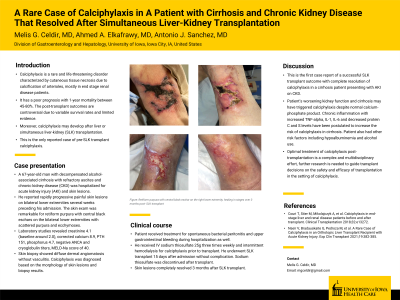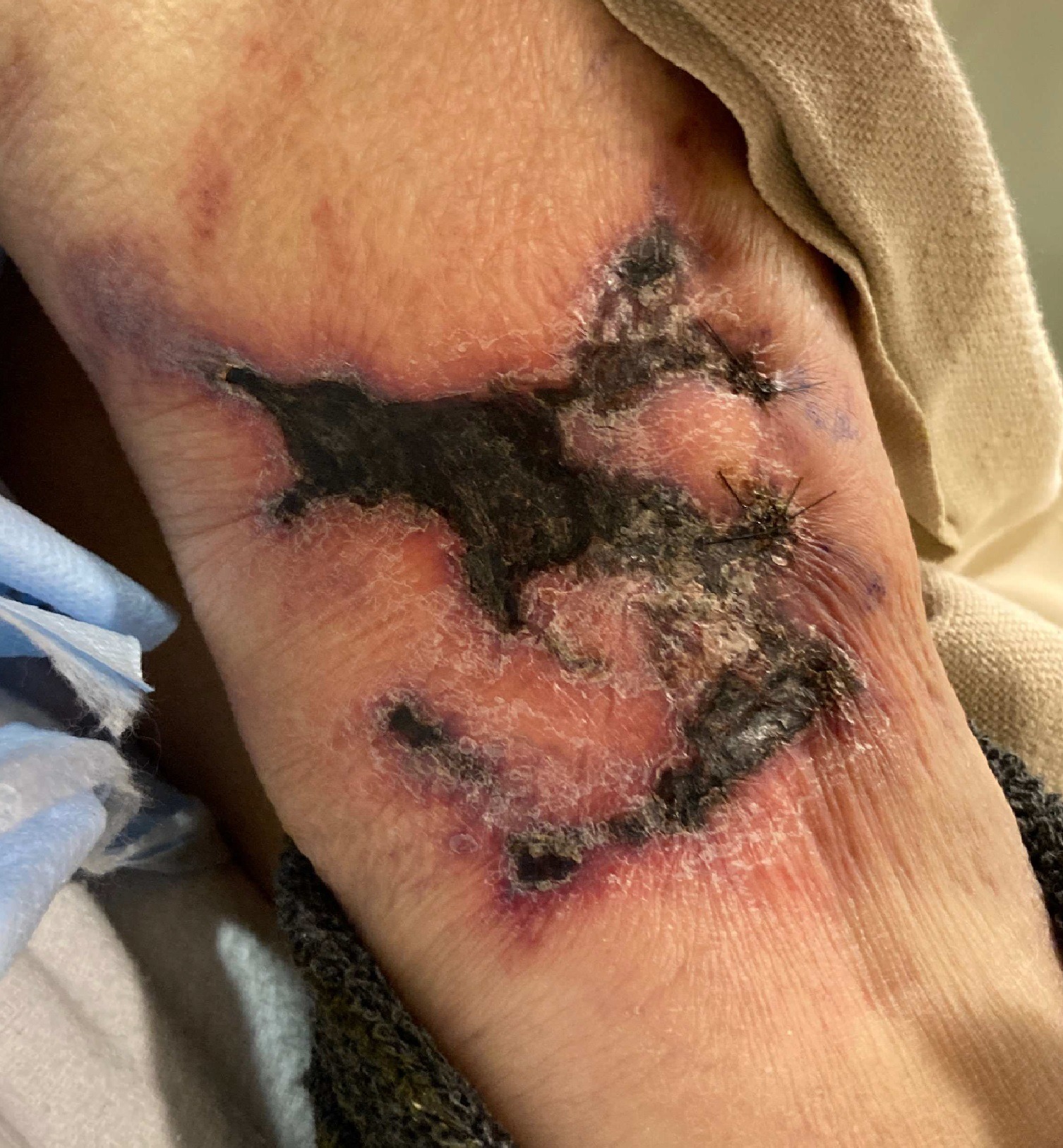Sunday Poster Session
Category: Liver
P1131 - A Rare Case of Calciphylaxis in a Patient With Cirrhosis and Chronic Kidney Disease That Resolved After Simultaneous Liver-Kidney Transplantation
Sunday, October 22, 2023
3:30 PM - 7:00 PM PT
Location: Exhibit Hall

Has Audio

Melis G. Celdir, MD
University of Iowa Hospitals & Clinics
Iowa City, IA
Presenting Author(s)
Melis G. Celdir, MD, Ahmed Elkafrawy, MD, Antonio Sanchez, MD
University of Iowa Hospitals & Clinics, Iowa City, IA
Introduction: Calciphylaxis is a rare and life-threatening disorder characterized by cutaneous tissue necrosis due to calcification of arterioles, mostly in end stage renal disease patients. It has a poor prognosis with 1-year mortality between 45-80%. The post-transplant outcomes are controversial due to variable survival rates and limited evidence. Moreover, calciphylaxis may develop after liver or simultaneous liver-kidney (SLK) transplantation. To our knowledge, this is the only reported case of pre-SLK transplant calciphylaxis.
Case Description/Methods: A 67-year-old man with decompensated alcohol-associated cirrhosis with refractory ascites and chronic kidney disease (CKD) was hospitalized for acute kidney injury (AKI) and skin lesions. He reported rapidly progressive painful skin lesions on bilateral lower extremities several weeks before admission. The skin exam was remarkable for retiform purpura with central black eschars on the bilateral lower extremities with scattered purpura and ecchymoses. Laboratory studies revealed creatinine 4.1 (baseline around 2.0), corrected calcium 8.9, PTH 151, phosphorus 4.7, negative ANCA and cryoglobulin titers, MELD-Na score of 40. Skin biopsy showed diffuse dermal angiomatosis without vasculitis. Calciphylaxis was diagnosed based on the morphology of skin lesions and biopsy results. He also received treatment for spontaneous bacterial peritonitis and upper gastrointestinal bleeding during hospitalization. He underwent SLK transplant 15 days after admission and received IV sodium thiosulfate 25g three times weekly and intermittent hemodialysis for calciphylaxis. Sodium thiosulfate was discontinued after transplant. Skin lesions completely resolved 3 months after SLK transplant.
Discussion: This is the first case report of a successful SLK transplant outcome with complete resolution of calciphylaxis in a cirrhosis patient presenting with AKI on CKD. His worsening kidney function and cirrhosis may have triggered calciphylaxis despite normal calcium-phosphate product. Chronic inflammation with increased TNF-alpha, IL-1, IL-6 and decreased protein C and S levels have been postulated to increase the risk of calciphylaxis in cirrhosis. Optimal treatment of calciphylaxis post-transplantation is a complex and multidisciplinary effort, further research is needed to guide transplant decisions and develop criteria on the safety and efficacy of transplantation in the setting of calciphylaxis.

Disclosures:
Melis G. Celdir, MD, Ahmed Elkafrawy, MD, Antonio Sanchez, MD. P1131 - A Rare Case of Calciphylaxis in a Patient With Cirrhosis and Chronic Kidney Disease That Resolved After Simultaneous Liver-Kidney Transplantation, ACG 2023 Annual Scientific Meeting Abstracts. Vancouver, BC, Canada: American College of Gastroenterology.
University of Iowa Hospitals & Clinics, Iowa City, IA
Introduction: Calciphylaxis is a rare and life-threatening disorder characterized by cutaneous tissue necrosis due to calcification of arterioles, mostly in end stage renal disease patients. It has a poor prognosis with 1-year mortality between 45-80%. The post-transplant outcomes are controversial due to variable survival rates and limited evidence. Moreover, calciphylaxis may develop after liver or simultaneous liver-kidney (SLK) transplantation. To our knowledge, this is the only reported case of pre-SLK transplant calciphylaxis.
Case Description/Methods: A 67-year-old man with decompensated alcohol-associated cirrhosis with refractory ascites and chronic kidney disease (CKD) was hospitalized for acute kidney injury (AKI) and skin lesions. He reported rapidly progressive painful skin lesions on bilateral lower extremities several weeks before admission. The skin exam was remarkable for retiform purpura with central black eschars on the bilateral lower extremities with scattered purpura and ecchymoses. Laboratory studies revealed creatinine 4.1 (baseline around 2.0), corrected calcium 8.9, PTH 151, phosphorus 4.7, negative ANCA and cryoglobulin titers, MELD-Na score of 40. Skin biopsy showed diffuse dermal angiomatosis without vasculitis. Calciphylaxis was diagnosed based on the morphology of skin lesions and biopsy results. He also received treatment for spontaneous bacterial peritonitis and upper gastrointestinal bleeding during hospitalization. He underwent SLK transplant 15 days after admission and received IV sodium thiosulfate 25g three times weekly and intermittent hemodialysis for calciphylaxis. Sodium thiosulfate was discontinued after transplant. Skin lesions completely resolved 3 months after SLK transplant.
Discussion: This is the first case report of a successful SLK transplant outcome with complete resolution of calciphylaxis in a cirrhosis patient presenting with AKI on CKD. His worsening kidney function and cirrhosis may have triggered calciphylaxis despite normal calcium-phosphate product. Chronic inflammation with increased TNF-alpha, IL-1, IL-6 and decreased protein C and S levels have been postulated to increase the risk of calciphylaxis in cirrhosis. Optimal treatment of calciphylaxis post-transplantation is a complex and multidisciplinary effort, further research is needed to guide transplant decisions and develop criteria on the safety and efficacy of transplantation in the setting of calciphylaxis.

Figure: Retiform purpura with central black eschar on the right lower extremity
Disclosures:
Melis Celdir indicated no relevant financial relationships.
Ahmed Elkafrawy indicated no relevant financial relationships.
Antonio Sanchez: Abbvie – Grant/Research Support. Arrowhead – Grant/Research Support. Boehringer-Ingelheim – Grant/Research Support. Escient – Grant/Research Support. Gilead – Grant/Research Support. Intercept Pharmaceuticals – Grant/Research Support. Inventiva – Grant/Research Support. Merck – Grant/Research Support.
Melis G. Celdir, MD, Ahmed Elkafrawy, MD, Antonio Sanchez, MD. P1131 - A Rare Case of Calciphylaxis in a Patient With Cirrhosis and Chronic Kidney Disease That Resolved After Simultaneous Liver-Kidney Transplantation, ACG 2023 Annual Scientific Meeting Abstracts. Vancouver, BC, Canada: American College of Gastroenterology.
